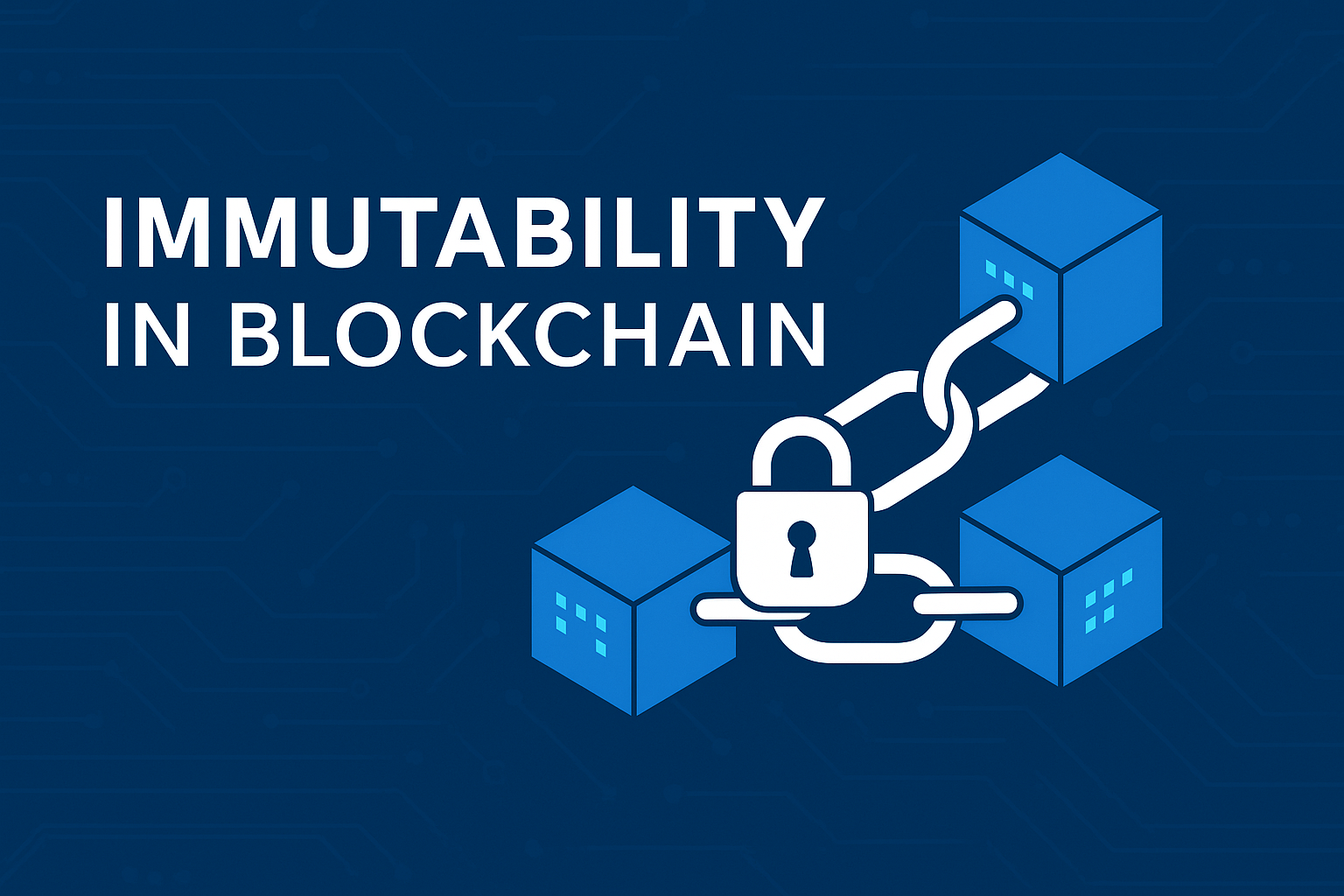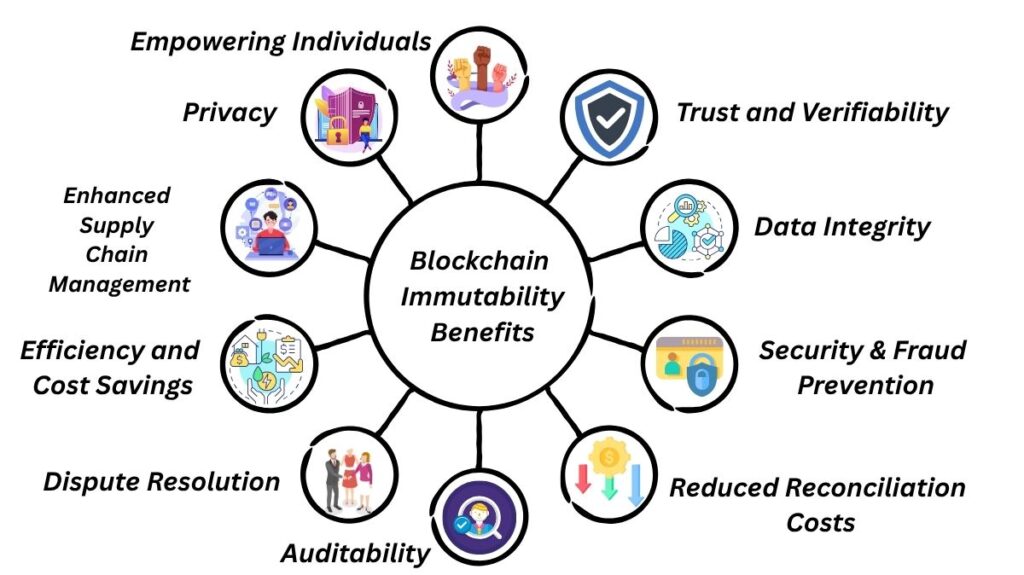In this article, we learn about Immutability Meaning in Blockchain, Blockchain Immutability Benefits, How Immutability is Achieved and Limitations
Immutability Meaning in Blockchain

Immutability in Blockchain
Immutable blockchain technology prevents data deletion, updating, and changing. The blockchain ledger stores unchangeable transactions. This electronic ledger is “write-once, append-many,” thus data must be logged sequentially and cannot be changed. Establishing integrity and trust inside the network depends on this quality.
Here is a detailed explanation of immutability and its implications:
How Immutability is Achieved
Blockchain immutability is primarily achieved through a combination of cryptographic techniques, distributed network architecture, and consensus mechanisms:
- Cryptographic Hashing and Chaining:
- The header or contents of the preceding block is cryptographically hashed in each block of the blockchain. Cryptography connects every digital chain block.
- The block’s transactions, creation time, and previous block’s hash are utilised to create SHA-256 hashes.
- Any previous block would have a significantly different unique hash if even a single piece of information were altered. This modification would subsequently render the hash contained in the next block invalid, hence rendering all subsequent blocks invalid as well. This process renders any attempt at manipulation instantly identifiable and impossible to hide computationally across the chain.
- As a digital signature, the hash identifies the precise input data; the hash result cannot be reverse-engineered to identify the original data.
- Consensus Mechanisms:
- The only way to update a blockchain is for its users to agree. Updates are checked against stringent standards established by the blockchain protocol rather than being governed by a single authority.
- Only after a consensus is reached by the entire network, usually using Proof of Work (PoW) or Proof of Stake (PoS) procedures, are new blocks added.
- Since it would take control of most nodes for an attacker to effectively change the shared ledger, this distributed validation makes the network extremely resistant to attacks.
- Decentralization:
- Distributed systems store data on a network of computers, or nodes, rather than a server. Each node keeps a copy of the blockchain.
- The distributed nature of the blockchain makes it challenging for one party to alter it since the network of self-sustaining users must reach an agreement.
- Immutable Data Structures:
- Information is summarized in a single root hash using data structures like Merkle trees, which are used to organize transactions hierarchically. This setup makes it easy to detect instances of data manipulation and permits the verification of transaction integrity.
You can also read What Is Cryptocurrency Address And Crypto Wallet Address
Blockchain Immutability Benefits

Immutability offers important benefits that set blockchain apart from conventional databases:
- Trust and Verifiability: It is a cornerstone for establishing trust, especially among untrusted parties, by providing a verifiable, auditable, and transparent record of every transaction, ensuring a single, public version of the truth.
- Data Integrity: Once a record is made, it cannot be changed or erased, ensuring that transactions and other data stored in the system are accurate and not interfered with.
- Security & Fraud Prevention: The blockchain’s tamper-proof nature prevents unauthorized data changes or erasure. Because change is immediately detectable through the use of cryptographic hashing and consensus procedures, bad behaviour is discouraged.
- Reduced Reconciliation Costs: Blockchain technology might lessen the need for reconciliation that is typical of traditional commercial applications by providing a distributed and independently verifiable “single version of the truth.”
- Auditability: Transaction auditing and ensuring the authenticity of records are made much easier by the impossibility to change data once it has been input. Fraud is reduced since auditors and authorities have a clear audit trail.
- Dispute Resolution: Tamper-free records offer conclusive evidence, allowing parties to rely on blockchain technology to resolve disputes by verifying ledger contents, potentially eliminating the need for third-party mediators.
- Efficiency and Cost Savings: Immutability removes hassles connected with data inspection and coordination, enhancing organizational efficiency, streamlining processes by eliminating intermediaries, and automating workflows.
- Enhanced Supply Chain Management: It enables end-to-end visibility and traceability, allowing participants to track goods, verify authenticity, and ensure compliance, thereby reducing fraud and improving inventory management.
- Privacy (in some contexts): Unlike standard databases, blockchain can offer enhanced privacy through anonymity and encrypted codes, making it difficult to detect user account information, though privacy levels depend on the specific blockchain and its features.
- Empowering Individuals: Blockchain empowers individuals by giving them control over their data, enabling secure management of digital identities, selective disclosure of information, and data ownership, leading to increased privacy and autonomy.
You can also read What Is A Cold Wallet Crypto?, Cold Wallet Benefits Overview
Nuances and Limitations (The “Almost Immutable” Aspect)
Although blockchains are frequently referred to as “immutable,” it is clear that this describes them as “practically impossible” to alter; rather, they are “tamper-evident and tamper-resistant.” Numerous difficulties and subtleties exist:
- 51% Attack: A malevolent person or group may be able to displace or change the most recent blocks if they take over more than 51% of the network’s processing power, or hash rate. On larger and more dispersed networks, however, this becomes computationally challenging and expensive.
- Weak Immutability of “Tail Blocks”: In the event of a brief network split, the most recently added blocks, referred to as “tail blocks” are most susceptible to being swapped out for a longer, alternate chain. A transaction is frequently deemed finished by users after they have waited for several following blocks.
- Smart Contracts and Bugs: Once implemented, smart contracts are also unchangeable by nature. If a fault or error occurs in a smart contract, it is permanently incorporated and cannot be fixed or patched. Although “escape hatches” or “workarounds” can be created for upcoming modifications, this presents a considerable obstacle. History demonstrates skepticism towards “unstoppable” smart contracts, such as the Ethereum hard fork following the DAO tragedy.
- Defunct Blockchains: A blockchain may become susceptible if a sizable portion of its publishing nodes or active users abandon it. This is because a malevolent actor can simply influence the few remaining nodes and change blockchain history.
- Legal and Regulatory Challenges: Data is unchangeable, making removal impossible, which may contradict with the “right to be forgotten” ( GDPR). Another issue is that illicit or offensive blockchain content is nearly impossible to erase.
- Scalability Concerns: It gets harder to guarantee immutability as blockchain networks expand. Network congestion and transaction throughput issues are two issues that might undermine node consensus, resulting in longer transaction times and more expensive fees.
- Quantum computing might understand a blockchain network’s public keys and uncover the private keys, endangering its immutability, experts believe.
- Energy Consumption: Proof-of-Work (PoW) based blockchain networks, like Bitcoin, require significant computational power and energy to maintain their immutable ledger, raising concerns about sustainability and environmental impact.
- Governance and Control: Immutable systems hinder network-wide consensus, blocking new protocols, upgrades, and improvements.
- User Experience: Complex interfaces and technology may slow blockchain adoption.
- Education and Awareness: Stakeholder blockchain ignorance limits adoption.
Overcoming Challenges
For privacy, regulatory compliance, error-correction, consensus algorithms, environmental sustainability, community involvement and governance, and future security, the blockchain architecture should include zero-knowledge proofs, upgradable contracts, Proof-of-Stake, and quantum crypto
You can also read What is Wrapped Ethereum in Blockchain And How it Works?
